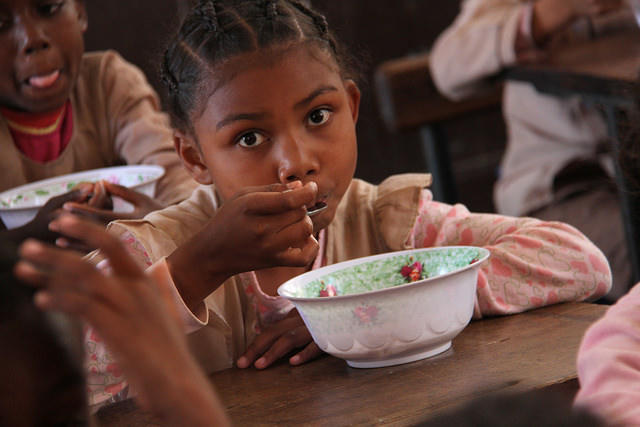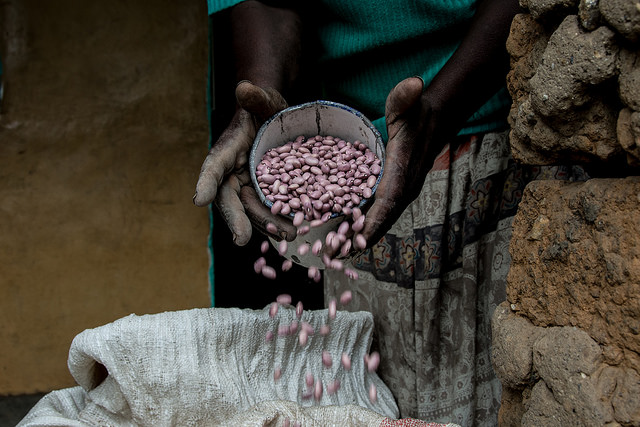Low-income communities need more affordable and nutritious food

A research project tackling malnutrition among vulnerable populations in Kenya and Uganda is launched in Nairobi today. The three-year initiative targeting women aged 15-49 years of reproductive age, and children aged 6−59 months, aims to develop a quick-to-cook porridge from at least four food groups, affordable for poor communities.
Poor dietary diversity among the poor is a key contributor to malnutrition, said Dr. Mercy Lung’aho, a nutritionist at the International Centre for Tropical Agriculture in Nairobi. Non-staple legumes such as beans and vegetables like amaranth can increase diet diversity for a more balanced diet. But the are often underutilized in diets, say researchers.
The project aims to create a win-win situation, improving nutrition of low-income vulnerable groups, while also benefiting smallholder farmers with improved income generating opportunities. It will do this by improving the availability, quality, safety and price of more nutritious foods cultivated by small holder farmers.
Understanding the value chain to benefit both consumers and farmers
A first step is to analyze malnutrition levels among a study group of poor households in Kenya and Uganda. That data will provide nutritional information about individual health, where families source food from, and how much they pay for it. This will help researchers understand which nutrients are a priority to add to the porridge.
“While a family may not have the resources to cook dry beans, vegetables, and cereals three times a day, they can boil this bean-based porridge which is nutrient dense and affordable, as an ideal supplement in the diet,” said Dr. Christine Chege, an agricultural economist and nutritionist at the International Centre for Tropical Agriculture in Nairobi.
Making safe, nutritious and affordable food available, especially for urban consumers, means working with the private sector and engaging everyone involved in food production – including farmers, say researchers.
Understanding how the whole food value-chain functions, including nutrient leakages and critical points of contamination – from food produced at the farmer’s gate to what arrives on the consumer’s plate – and evaluating how nutrition can be optimized and transaction cost reduced throughout this chain, is vital to supply nutritious foods to the poor.

School feeding program supported by CIAT in Madagascar. Credit: S.Malyon / CIAT
Linking farmers to more nutritious markets
Researchers aim to benefit rural and urban consumers, reaching around five million small holder farmers in Uganda and Kenya by the end of the project. An analyses of business bottle-necks to reduce costs along the value chain – for example using low-cost, energy-efficient dryers instead of electricity – will be made, and bean farmers will be linked with processors through inclusive business models.
Dr. Marcus Nagle, from a research team at the University of Hohenheim in Germany, which is evaluating the energy efficient dryers, said: “We are very excited to evaluate the dryer performance in the local climates of Kenya and Uganda with a focus on the specific key staples of the region. We expect that solar drying will be more safe and reliable, with an improved product quality, especially in respect to insect and fugal infestations.”
In conjunction with an economic evaluation carried out by the University of Göttingen, it should become apparent whether this technology can be cost-effective on a wider perspective for local villages and cooperative in Eastern Africa, he added.
Agriculture, nutrition and the urban consumer

Beans are a great source of nutrition for low-income households. Credit: G.Smith / CIAT
Although foods made with multiple ingredients – cereals, legumes, and vegetables – already exist, they are not tailored to low-income, malnourished children and women, researchers noted.
For the most part, industrial food processing caters mainly to middle and high-income consumers, with little attention devoted to lower-income groups. Nutritious foods are developed, produced, distributed, and marketed in ways that do not take into account the economic and social circumstances of poorer consumers.
The project aims to analyse and upgrade bean-based value chains in Kenya and Uganda, while ensuring that results are used by the private sector and others who can influence and improve the supply, price, and quality of more nutrient-dense food for vulnerable communities. The project will work to influence decision-makers by linking project interventions to the strategies and plans of national nutrition programs.
Under CIAT’s overall coordination, partners will report to the project through PABRA – the Pan-African Bean Research Alliance. All partners have longstanding experience in working with farmers and private sector partners as well as strong channels to local authorities and policy-shapers, which will play an important role in scaling out research results in PABRA’s 30 member countries.
“Making Value Chains Work for Food and Nutrition Security of Vulnerable Populations in East Africa’ is supported by BMZ and GIZ, and is a Pan-Africa Bean Research Alliance initiative. The project will be led by the International Center for Tropical Agriculture, in collaboration with The University of Hohenheim (UHOH), the University of Göttingen (UGOE), the Kenya Agriculture and Livestock Research Organization (KALRO) and Ugandan Nutrition and Agriculture Research Organization (NARO).
